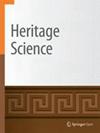Corrosion analysis of unearthed jade from Daye Zhen Tomb of Northern Zhou Dynasty
IF 2.6
1区 艺术学
Q2 CHEMISTRY, ANALYTICAL
引用次数: 0
Abstract
Abstract X-ray fluorescence spectroscopy, scanning electron microscopy energy spectrum, excitation-emission matrix spectroscopy, and Fourier transform infrared spectroscopy was applied to the unearthed jade with multilayered corrosion, to reveal the microstructure, composition structure, and distribution of organic matters. Our results showed that the interior of the jade was mainly composed of layered serpentine with a regular structure, while the white layer structure on the surface is scattered and irregular, and the content of calcite formed by elements Ca and C increases significantly; between the green matrix and the white layer on the surface, there are brown corrosion zones with obvious fluorescence effect and mainly composed of humic acid, which continuously extends inward along the corrosion cracks for accelerating the internal corrosion. This article, for the first time, argued for the corrosive and fluorescent humic acid bands that appear inside serpentine jade and cautions its role in investigating the corrosion of jade.

北周大业镇墓出土玉的腐蚀分析
摘要采用x射线荧光光谱、扫描电镜能谱、激发发射矩阵光谱和傅里叶变换红外光谱等方法对出土的多层腐蚀玉石进行了显微组织、成分结构和有机质分布的研究。结果表明:玉石内部主要由层状蛇纹石组成,结构规则,表面白色层状结构零散不规则,Ca、C元素形成的方解石含量显著增加;在表面绿色基体与白色基体之间,存在以腐植酸为主的棕色腐蚀带,荧光效应明显,腐蚀带沿腐蚀裂纹不断向内延伸,加速了内部腐蚀。本文首次论证了蛇纹石玉石内部存在腐蚀性和荧光腐植酸带,并指出了其在玉石腐蚀研究中的作用。
本文章由计算机程序翻译,如有差异,请以英文原文为准。
求助全文
约1分钟内获得全文
求助全文
来源期刊

Heritage Science
Arts and Humanities-Conservation
CiteScore
4.00
自引率
20.00%
发文量
183
审稿时长
19 weeks
期刊介绍:
Heritage Science is an open access journal publishing original peer-reviewed research covering:
Understanding of the manufacturing processes, provenances, and environmental contexts of material types, objects, and buildings, of cultural significance including their historical significance.
Understanding and prediction of physico-chemical and biological degradation processes of cultural artefacts, including climate change, and predictive heritage studies.
Development and application of analytical and imaging methods or equipments for non-invasive, non-destructive or portable analysis of artwork and objects of cultural significance to identify component materials, degradation products and deterioration markers.
Development and application of invasive and destructive methods for understanding the provenance of objects of cultural significance.
Development and critical assessment of treatment materials and methods for artwork and objects of cultural significance.
Development and application of statistical methods and algorithms for data analysis to further understanding of culturally significant objects.
Publication of reference and corpus datasets as supplementary information to the statistical and analytical studies above.
Description of novel technologies that can assist in the understanding of cultural heritage.
 求助内容:
求助内容: 应助结果提醒方式:
应助结果提醒方式:


